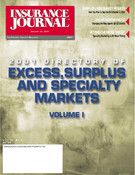In the race to capture an increasing sharing of the consumer’s wallet, regulated financial institutions are lining up in droves in this post-Glass Steagall era to market a wider array of consumer financial product to existing customers. After all, with the advent of the Internet, new distribution channels have opened. Coupled with a more appropriate regulatory regime, there is no longer anything stopping an insurance company from selling banking services.
Indeed, the market is alive with such experimentation, starting at the top with players like Allstate, AIG and State Farm, and reverberating all the way through the insurance industry auditorium. The industry is now alive with such music and quite possibly, insurance executives will now have a chance to capture some incremental growth and expand their business units around the notion of cross-financial service sales.
At the same time, a new breed of cross-financial organizations called financial aggregators are entering the scene. Powered by infrastructure players Vertical One and Yoodle, old and new financial institutions are using aggregating agents and technology to pull together their customer’s financial information and maybe, just maybe, get a look at where and how the customer manages complete financial assets and wealth.
Commercial banks may have been first on the dance floor, but insurers will surely be next. Say you’re a large bank and your retail deposit customer decides to aggregate away from you. This means that an intelligent little Martian agent crafted in the engineering departments of Yoodle or Vertical One will now swoop in, stealth-like, unlock your customer’s information with a UserID and password combination, and return to its lair at another institution’s site. Any CEO will likely declaim that no such swooping and information plucking will exist under his/her guard.
Thus, we have traditional financial institutions and new information aggregation technologies being used by traditional financial institutions seeking to cross-sell financial services to existing customers. Does it really make any sense?
Our belief is no, that traditional financial institutions will see little economic value from cross-selling financial products. Whether the strategy taken is concentric consolidation, akin to the Citi-Travelers approach; or narrow cross-selling or partnership cross-selling, like Chase’s approach to cross-selling business insurance or information aggregation services; the traditional institution remains a dyed-in-the wool supplier whose bias will always be product and not customer need. Insurance companies obviously fit this description.
What does it mean to approach this wonderful panacea of cross-financial product selling from the position of supplier? First, supply always comes first. Say you are General Motors and your customer comes to you seeking a Ford, or even better, is more suited for a Ford and you realize it but the customer does not. Do you sell the customer a Ford? Absolutely not. So, if he needs a Ford who is likely to tell him and help him get one? The answer is a neutral or even buyer-oriented organization.
Let’s take this example closer to home. A traditional financial institution today largely builds product around a relationship manager. In insurance, many of those relationship managers are truly independent, but this doesn’t affect the equation. Financial suppliers have developed a complete suite of products around those relationship managers and grant incentives to sell, sell and sell. There are no built-in incentives to serve customer needs. Even worse, in many financial product lines, there are imperfect or even no disclosure requirements.
In light of this business configuration where supply is shaped around a relationship and then sold aggressively to customers, it makes perfect sense to add incremental, captive product to leverage the relationship management already in place. Thus, the winds of cross-selling, unleashed through Glass-Steagall’s collapse, blow fiercely across the financial industry. Add to this the growth of a new distribution channel where both old and new product can be packaged together, and it makes even more sense to sell every and any financial product imaginable.
Yet we are still left with a situation where a true Ford buyer has to learn he needs a Ford, and instead he is falling increasingly under the hypnotic trance of the relationship manager now selling not just GM but Buick, Chrysler and Range Rover products. This creates quite a pickle, particularly if you are a financial executive and must respond to the competitive pressures that industry places on you to cross-sell financial product.
Financial executives must reason why, why does cross-selling make sense? The answer they will come to-to expand the offerings available to relationship management- may ring incongruently with the bald facts. Those facts-still surrounded by the miasma of confusion created by the Internet-are that financial suppliers must narrow, not enlarge, their product focus and also redesign, not eliminate, their relationship management distribution. Clearly, the Internet will allow best choices to emerge and to be assembled by new information or fulfillment organizations. We see this in companies like Answer Financial, true buyer-oriented fulfillment centers that act in the buyer’s interest and pick and choose among the best available supply. So instead of assembling a mixture of good, bad and indifferent products, the wavering financial executive must not only question, but also begin pruning, to be successful.
More importantly, the executive must address some of the inherent weaknesses in current relationship management. First, the moral hazard that may exist to the buyer when commission-sharing or other pecuniary relationships exist with the relationship management and are not disclosed must end. Suppliers need to ensure buyers are fully aware lest the buyer move elsewhere.
Secondly, the information flow between supplier and buyer must not be disrupted by the relationship manager, particularly when he is an independent agent. Buyers should see clearly the full hand they are dealt by suppliers when bids come in. The hand should not be reassembled by the relationship manager to best serve his interest. It goes without saying that suppliers in all segments could work on reducing total costs and passing them on to the end customer.
In sum, we are seeing a whirlwind of activity in the rush to cross-sell financial product. From the vantage point of the supplier, these activities represent deadweight losses that shareholders will undoubtedly bear. Take heed, financial executives-your fate was sealed when you entered the financial supplier world. Your job is to manufacture supply as efficiently as possible, earn a respectable return on your capital, and better your customer relationships with improved service and lower costs through some of the new information technology readily available to you.
Apart from this and perhaps some time off on the weekends, there is little you can do to avoid your fate. Cross-selling a full suite of financial product was never in your cards, and simply won’t be!
Gary Craft runs FinancialDNA, an e-finance research and publishing website. His regular writings, along with other e-finance insights, can be found at his website, www.financialdna.com. To comment, send e-mail to ijwest@insurancejournal.com.
Was this article valuable?
Here are more articles you may enjoy.


 US Roof Maintenance Lags: Hanover
US Roof Maintenance Lags: Hanover  State Farm Seeking Large Rate Increases in Wildfire-Prone California
State Farm Seeking Large Rate Increases in Wildfire-Prone California  Ryan Specialty Announces Succession Plan: Pat Ryan to Exec Chair, Turner to Be CEO
Ryan Specialty Announces Succession Plan: Pat Ryan to Exec Chair, Turner to Be CEO  Update: Beryl Rakes Mexico’s Yucatan With Hurricane Winds and Heavy Rain
Update: Beryl Rakes Mexico’s Yucatan With Hurricane Winds and Heavy Rain 


